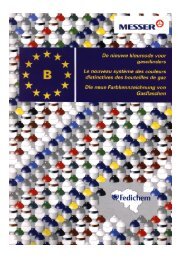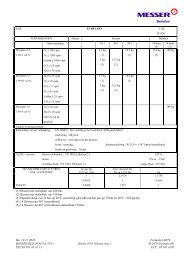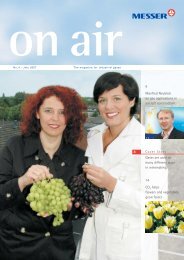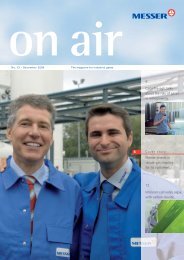8 6 Helmut Gutenberger and Wojciech Pastuszczyn on ... - Messer
8 6 Helmut Gutenberger and Wojciech Pastuszczyn on ... - Messer
8 6 Helmut Gutenberger and Wojciech Pastuszczyn on ... - Messer
Create successful ePaper yourself
Turn your PDF publications into a flip-book with our unique Google optimized e-Paper software.
Today we need lead as much as we ever did,<br />
though the number of applicati<strong>on</strong>s has decreased<br />
sharply. “The popularity that this metal enjoyed just<br />
a few decades ago has declined markedly. This is due<br />
partly to the health hazards <str<strong>on</strong>g>and</str<strong>on</strong>g> envir<strong>on</strong>mental polluti<strong>on</strong><br />
associated with lead compounds, which were<br />
caused by outdated producti<strong>on</strong> methods, <str<strong>on</strong>g>and</str<strong>on</strong>g> partly<br />
to the issue of ec<strong>on</strong>omic efficiency”, explains<br />
Burkhardt Holleis from Applicati<strong>on</strong> Technology<br />
Metallurgy at <strong>Messer</strong> Austria.<br />
Nevertheless, the heavy metal is still of great<br />
value, particularly for special applicati<strong>on</strong>s such as<br />
radiati<strong>on</strong> shields or in accumulators such as car batteries.<br />
Lead (latin Plumbum, chemical symbol Pb) is a very<br />
soft <str<strong>on</strong>g>and</str<strong>on</strong>g> malleable heavy metal with a low melting<br />
point. It very rarely occurs in its pure form in nature,<br />
with lead sulphide (PbS, blue lead, galenite) being<br />
the most important lead mineral. The most frequent<br />
natural deposits are found in seams where the galenite<br />
is mainly found in combinati<strong>on</strong> with zinc blende<br />
(ZnS, sphalerite) <str<strong>on</strong>g>and</str<strong>on</strong>g> pyrite (FeS2, ir<strong>on</strong> pyrite).<br />
Primary lead<br />
“Lead metal can either be produced from lead ores<br />
(primary lead) or recycled products (sec<strong>on</strong>dary lead)”,<br />
says Holleis. In primary lead producti<strong>on</strong>, the lead ore<br />
is first c<strong>on</strong>verted, by means of physical processes,<br />
into a fine-grained c<strong>on</strong>centrate with maximum<br />
metal c<strong>on</strong>tent - this process is called ore dressing.<br />
The ore is crushed <str<strong>on</strong>g>and</str<strong>on</strong>g> graded in several stages.<br />
<strong>on</strong> air 09 · 2008<br />
During the subsequent flotati<strong>on</strong> in an emulsi<strong>on</strong>, the<br />
fine-grained solids are separated from <strong>on</strong>e another.<br />
In order to c<strong>on</strong>vert the enriched lead sulphide into<br />
metals in classic smelting, it is roasted in the sinter<br />
plant with the additi<strong>on</strong> of hot air. The liquid lead<br />
oxide that is separated in this process is reduced to<br />
metallic lead bulli<strong>on</strong> <str<strong>on</strong>g>and</str<strong>on</strong>g> slag in a shaft furnace with<br />
the aid of coke, lime <str<strong>on</strong>g>and</str<strong>on</strong>g> ir<strong>on</strong>. “By adding oxygen,<br />
this process becomes even more effective”, explains<br />
Burkhardt Holleis.<br />
Modern technological methods involve direct<br />
reducti<strong>on</strong> processes. The advantage here relates to<br />
the greater efficiency of the plants, in which the<br />
roasting <str<strong>on</strong>g>and</str<strong>on</strong>g> reducti<strong>on</strong> processes take place in <strong>on</strong>e step.<br />
“Accordingly, envir<strong>on</strong>mental polluti<strong>on</strong> is reduced <str<strong>on</strong>g>and</str<strong>on</strong>g><br />
ec<strong>on</strong>omic efficiency increased”, says the expert.<br />
Roasting is not fully completed <str<strong>on</strong>g>and</str<strong>on</strong>g> lead oxide<br />
can react with lead sulphide to form metallic lead.<br />
This produces lead bulli<strong>on</strong> <str<strong>on</strong>g>and</str<strong>on</strong>g> slag with a higher<br />
lead c<strong>on</strong>centrati<strong>on</strong> than with the previously menti<strong>on</strong>ed<br />
process. The reducti<strong>on</strong> of the slag means<br />
that the remaining lead in it can also be recovered<br />
as a resource. “Here, too, oxygen is used in order to<br />
keep down the producti<strong>on</strong> costs”, says Holleis,<br />
highlighting another advantage of the use of oxygen<br />
in smelting. The raw lead now has to be refined<br />
before further processing.<br />
Sec<strong>on</strong>dary lead<br />
Liquid lead being tapped from<br />
a short rotary furnace<br />
It is not just the lead in lead-acid batteries that is<br />
recycled, but also the plastic housing <str<strong>on</strong>g>and</str<strong>on</strong>g> the sulphuric<br />
Cover story : 9<br />
YOUR CONTACTS:<br />
Burkhardt Holleis<br />
Applicati<strong>on</strong> Technology Metallurgy<br />
<strong>Messer</strong> Austria GmbH<br />
Tel.: +43 (0) 50603-281<br />
burkhardt.holleis@messergroup.com<br />
Languages:<br />
Dr. Martin Demuth<br />
Applicati<strong>on</strong> Technology Metallurgy<br />
<strong>Messer</strong> Austria GmbH<br />
Tel.: +43 (0) 50603-205<br />
martin.demuth@messergroup.com<br />
Languages:<br />
c<strong>on</strong>tinued <strong>on</strong> page 10












